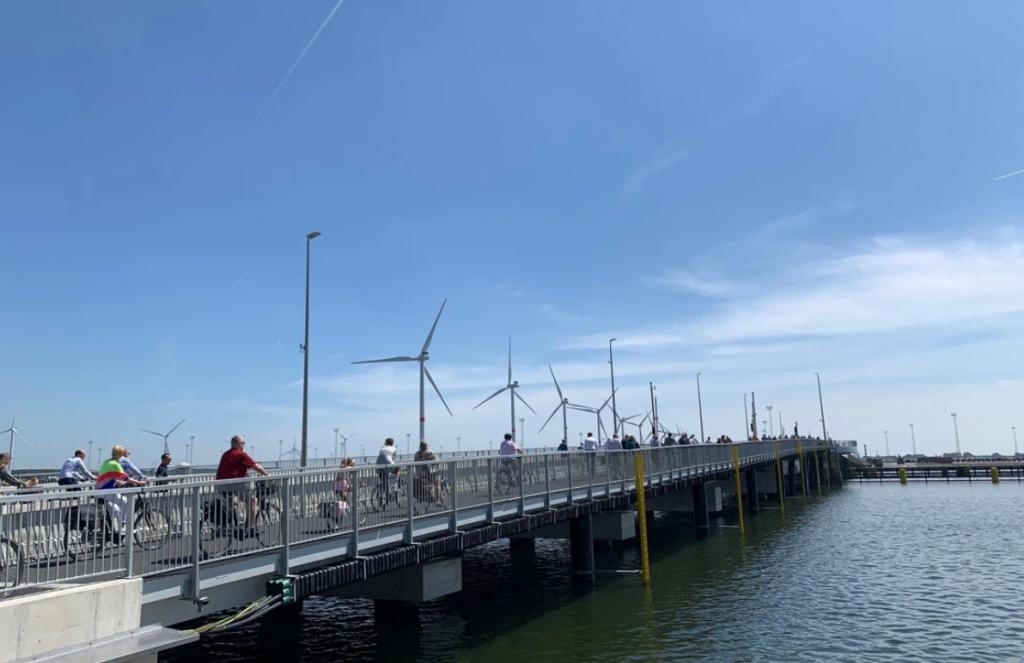Thessaloniki gets ready for its metro launch in November
The underground rapid transit lines have been under construction for almost two decades due to various project delays
 TheMayor.EU logo
TheMayor.EU logo 
The longest swing bridge in Europe connects both sides of the port for cars, pedestrians and cyclists, Source: Port Antwerp-Bruges
Apart from car lanes, the 130-metre-long structure also features a 4-metre-wide bike lane
Last week, port authorities in the new joint Antwerp-Bruges inaugurated the longest swing bridge in Europe. The bridge construction took an investment of 34 million euros. It was completed during the pandemic and now boasts an impressive length of 130 metres, a passage width of 55 metres and a bike path wide 4 metres.
The new infrastructure was aimed at improving the connections between the outer and inner harbours at Zeebrugge, while the moving parts of the bridge would allow large sea-bound vessels to access the inland portions of the port.
During the inauguration ceremony, the mayor of Bruges, Dirk De Fauw, invited both local residents, port staff and bridge enthusiasts to cycle over it for the first time. He explained that the bridge was an important addition to cycling infrastructure both in Bruges and in the port.
This is because it forms an integral part of a six-kilometre bike route, leading to the port which will enable sustainable commutes from Bruges both to Zeebrugge and the Belgian coast.
At the end of April, authorities in Bruges and Antwerp announced that the cities signed a landmark shareholders’ merger agreement for the two ports. The new Antwerp-Bruges port is supposed to become a global trading hub for moving goods.
Work on the merger started back in early 2021 and when it was complete, Antwerp-Bruges accounted for 74,000 direct and 90,000 indirect jobs. Furthermore, it accounted for 21 billion euros of income for Belgium or about 4.5% of the country’s entire GDP.
These figures make it the largest economic engine in Belgium and put it among the largest European export ports, the largest vehicle transhipment ports and the largest integrated chemical clusters on the continent. On top of that, the port of Antwerp-Bruges has a robust climate strategy, that aims to combine a strong economic output with sustainability goals.
According to a statement by the city of Bruges, by 2025, the port will be capable of capturing 2.5 million tons of CO2 from local industry, that could be stored and eventually reused. At the same time, by 2028, the port aims to be able to receive the first green hydrogen shipments. The bid for expanding hydrogen includes providing pipe infrastructure between the two cities, that would then connect Belgium with the rest of Europe.

The underground rapid transit lines have been under construction for almost two decades due to various project delays

Now you can get your wine in Talence by paying directly in Bitcoin

That’s because the state has to spend money on updating the railway infrastructure rather than subsidizing the cost of the popular pass

Rethinking renewable energy sources for the urban landscape

The examples, compiled by Beyond Fossil Fuels, can inform and inspire communities and entrepreneurs that still feel trepidation at the prospect of energy transition

Now you can get your wine in Talence by paying directly in Bitcoin

The 10th European Conference on Sustainable Cities and Towns (ESCT) sets the stage for stronger cooperation between the EU, national and local level to fast track Europe's transition to climate neutrality.

At least, that’s the promise made by the mayor of Paris, Anne Hidalgo

The underground rapid transit lines have been under construction for almost two decades due to various project delays

At least, that’s the promise made by the mayor of Paris, Anne Hidalgo

Hostal de Pinós is located in the geographical centre of the autonomous region

Despite its church-y name, the district has long been known as the hangout spot for the artsy crowds

Urban dwellers across the EU are having a say in making their surroundings friendlier to people and the environment.

Forests in the EU can help green the European construction industry and bolster a continent-wide push for architectural improvements.

Apply by 10 November and do your part for the transformation of European public spaces

An interview with the Mayor of a Polish city that seeks to reinvent itself

An interview with the newly elected ICLEI President and Mayor of Malmö

A conversation with the Mayor of Lisbon about the spirit and dimensions of innovation present in the Portuguese capital














